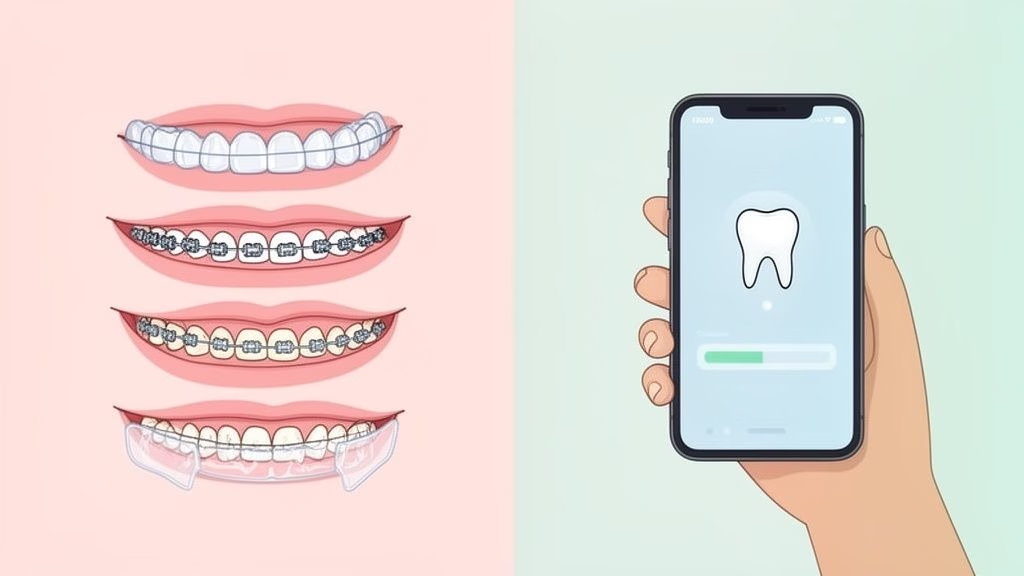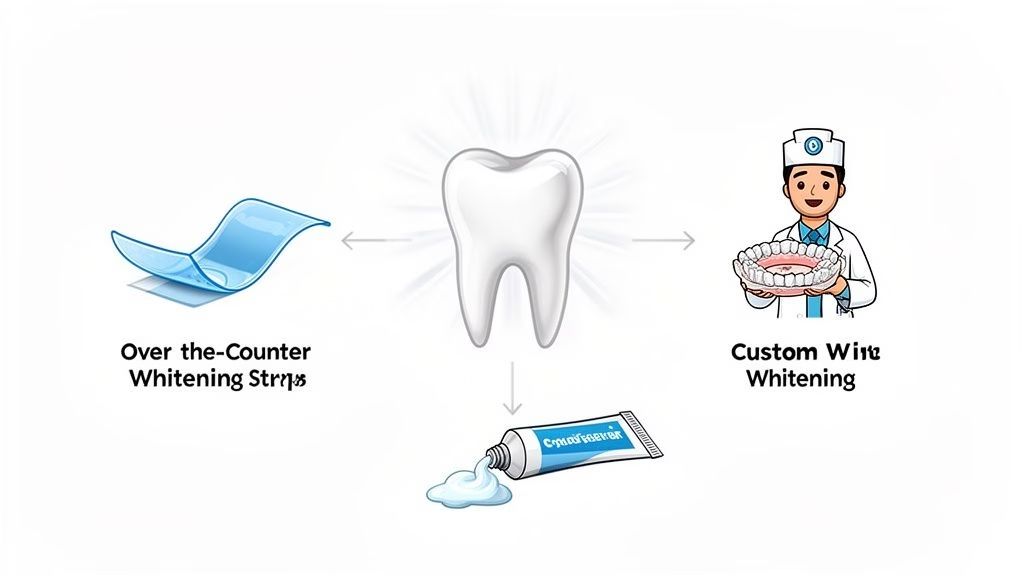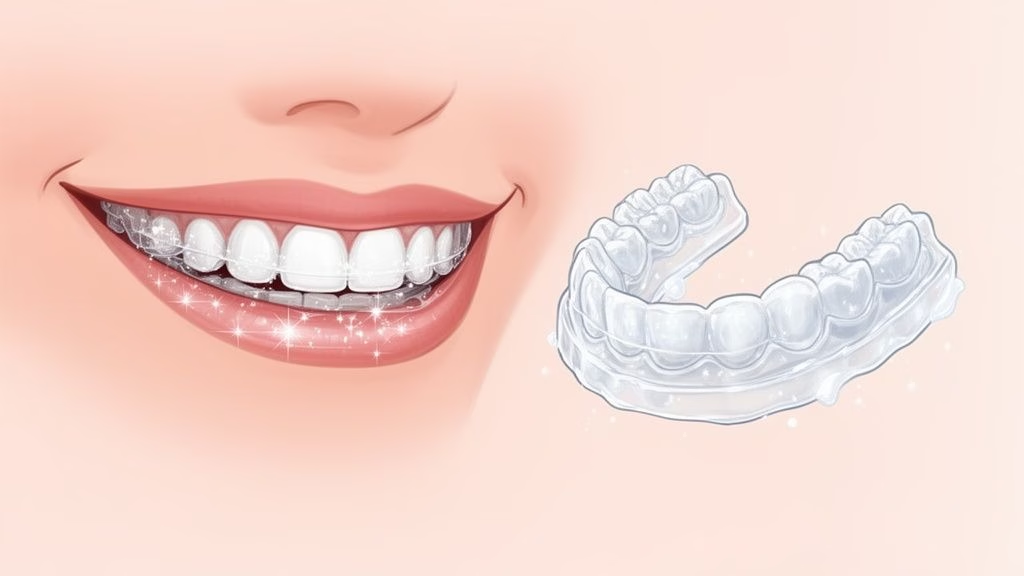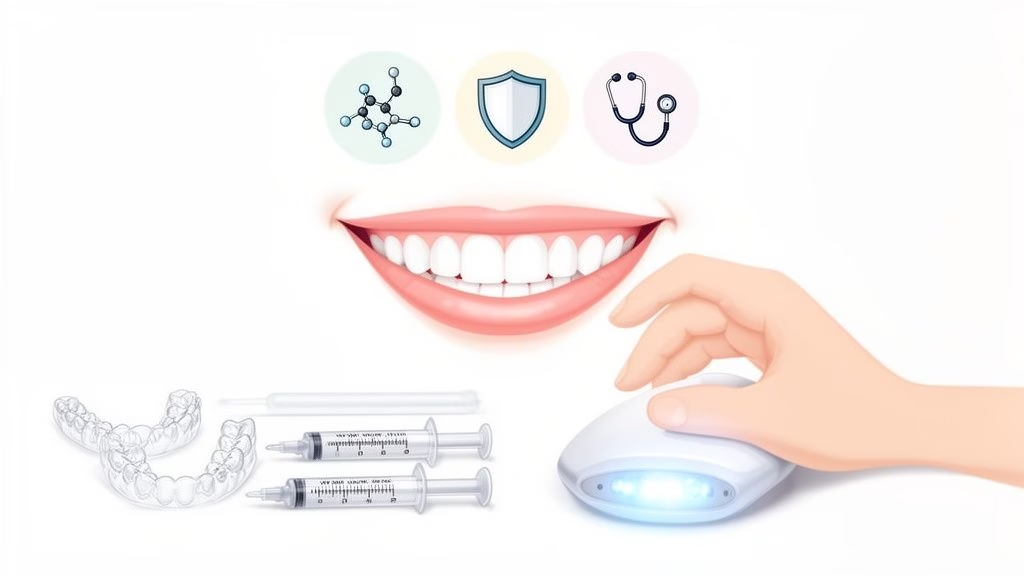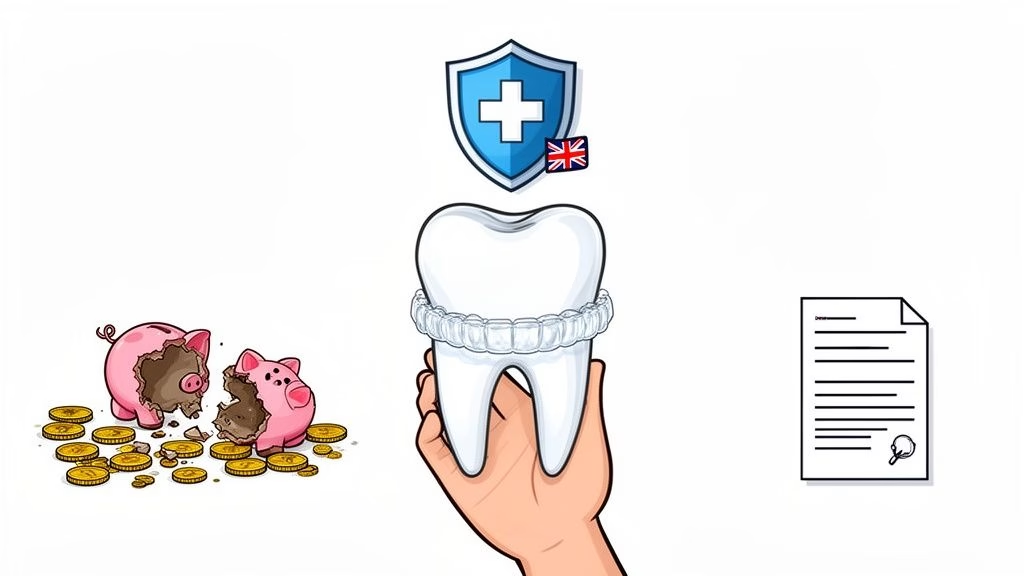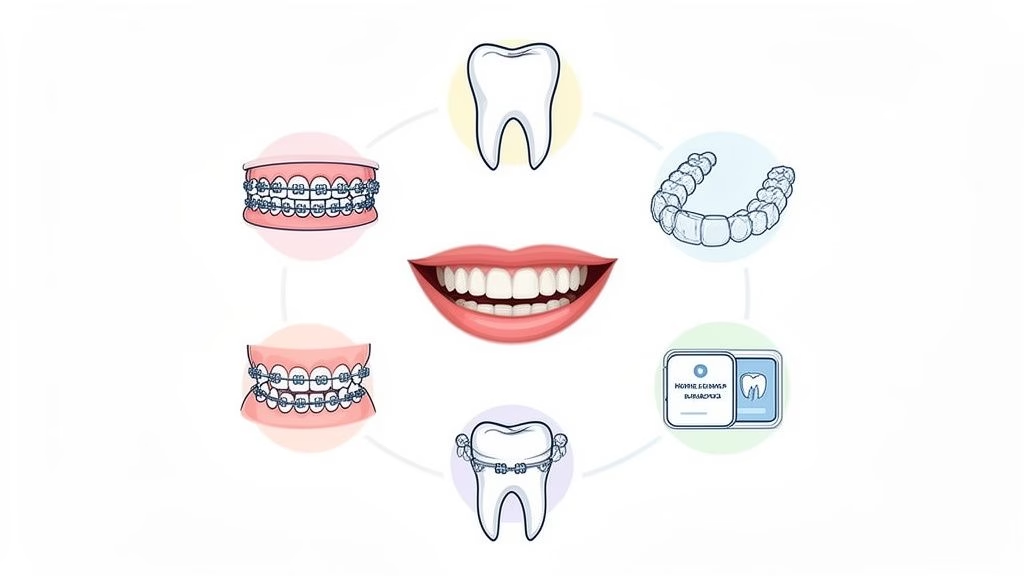What Causes Tooth Discoloration in the UK?
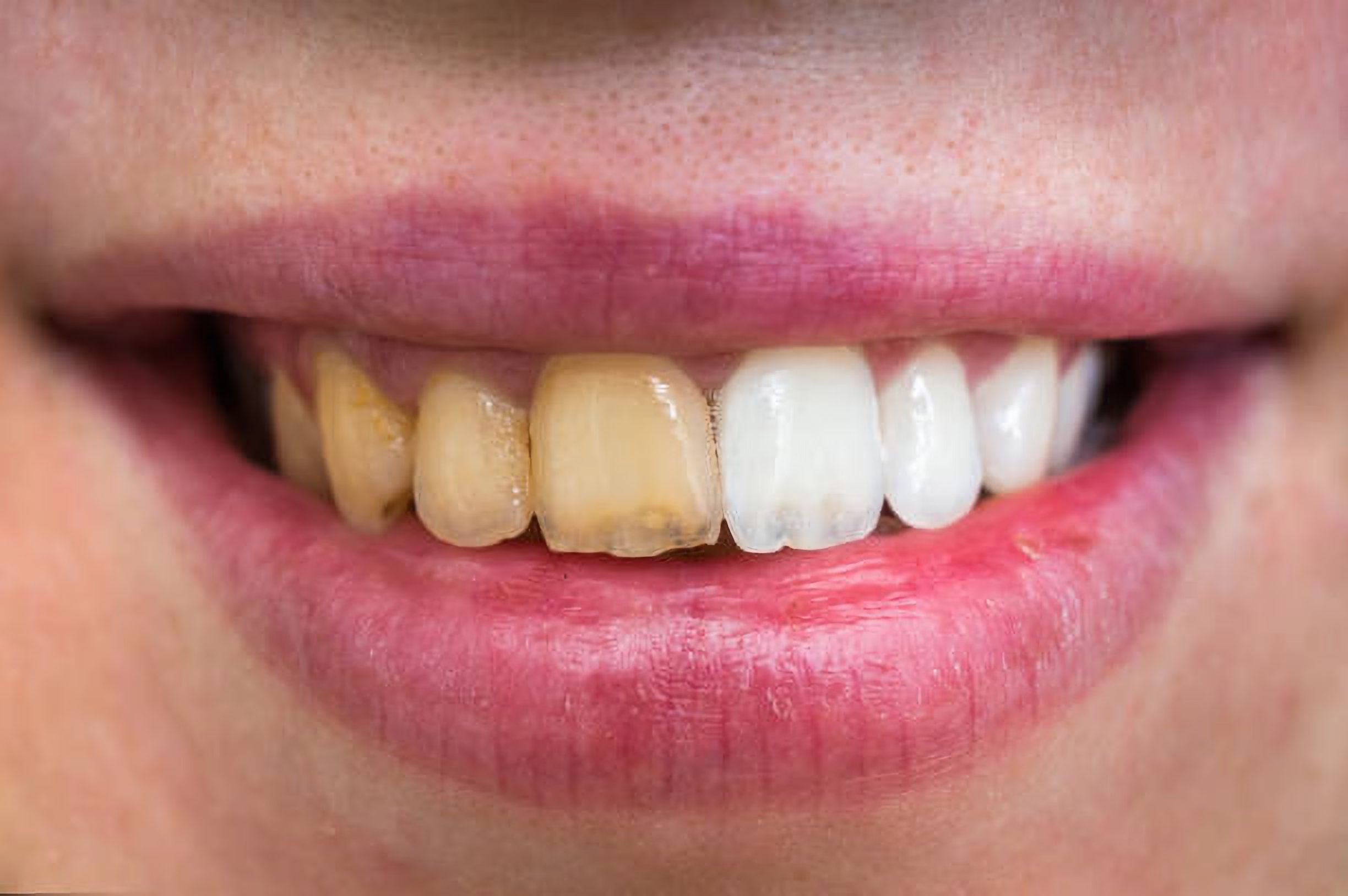
Have you ever noticed your smile isn’t as bright as it used to be? It’s a common experience, but the reasons why can be quite different from person to person. The change in your teeth’s colour usually boils down to two main culprits: extrinsic stains, which are on the surface, and intrinsic stains, which come from deep inside the tooth. Things like your diet, certain habits, getting older, and even past injuries can all affect the colour of your smile.
Understanding Why Teeth Change Colour
So, what’s really going on when your teeth start to look a bit dull or yellow? Thinking about the “why” is the first real step toward finding a solution that actually works.
Imagine your tooth is like a white t-shirt. Some discolouration is like spilling a bit of coffee on it – a surface stain that you can often wash out. But other changes are more like the fabric itself fading or changing colour from the inside out. That’s the core difference we’re talking about.
This distinction is key to getting your smile back on track. The two categories are:
- Extrinsic Stains: These are the stains that build up on the very outer layer of your tooth, known as the enamel. They’re usually caused by colourful pigments from the food and drink we love, or from habits like smoking.
- Intrinsic Stains: These stains happen inside the tooth, affecting the softer, more yellow layer beneath the enamel called dentin. This can be due to things like ageing, certain medications, or an injury that affected the tooth’s development.
This simple diagram helps visualise how different causes lead to these two types of staining.
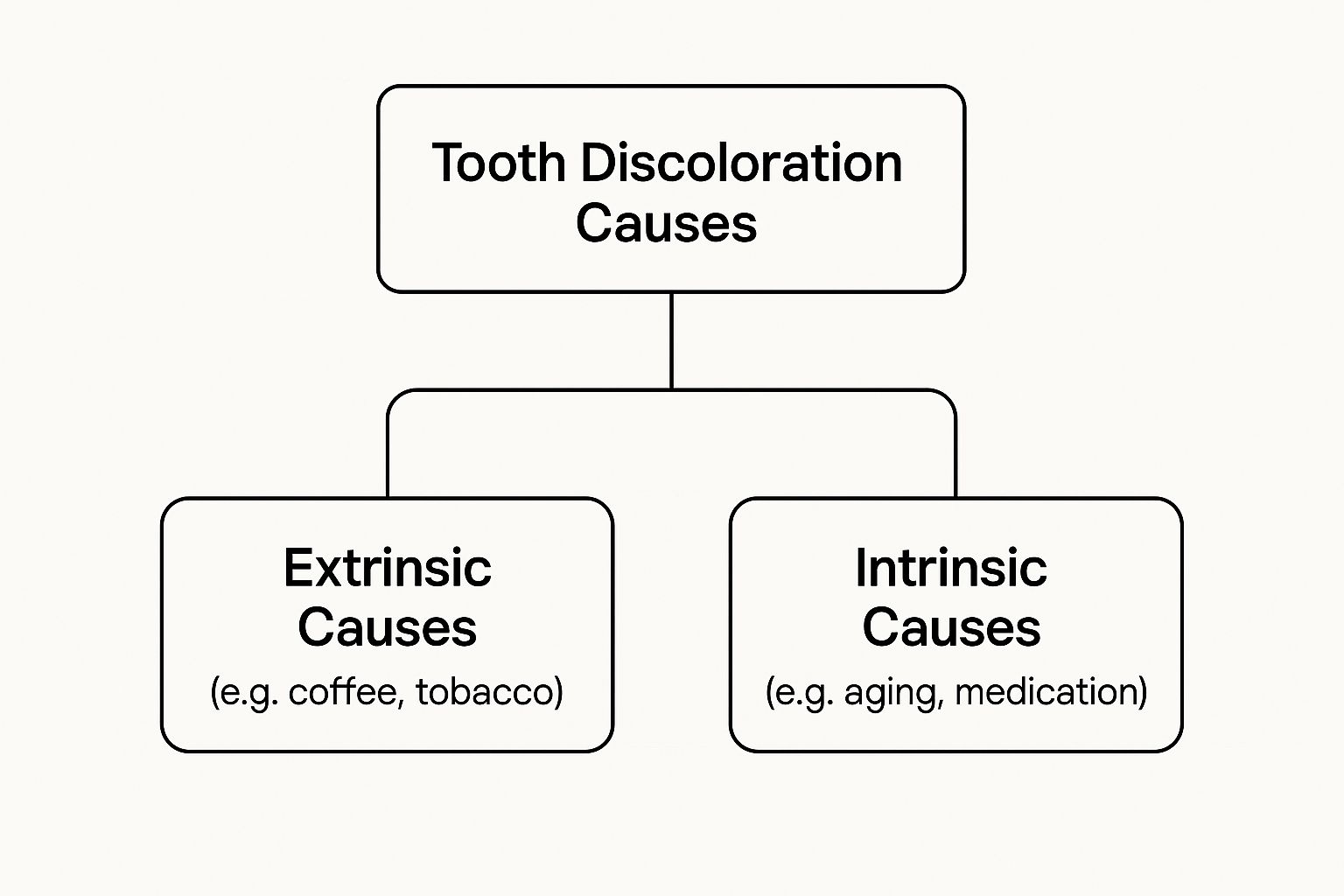
As you can see, figuring out whether your staining is on the outside or coming from within is the most important clue for choosing the right treatment.
The Two Main Causes of Discolouration
To get a clearer picture, let’s take a quick look at both types of staining side-by-side. This table breaks down the key differences at a glance.
Extrinsic vs Intrinsic Discolouration At a Glance
| Stain Type | Where It Occurs | Common Causes | Best Approach |
|---|---|---|---|
| Extrinsic | On the tooth’s surface (enamel) | Coffee, tea, red wine, smoking, dark berries | Professional cleaning, whitening toothpaste, at-home whitening |
| Intrinsic | Inside the tooth’s core (dentin) | Ageing, injury/trauma, certain medications, genetics | Professional whitening, veneers, bonding, crowns |
This quick comparison shows why a one-size-fits-all approach to whitening rarely works. The solution needs to match the problem.
Digging a Little Deeper
Extrinsic staining is what most people are dealing with. It’s the gradual build-up from things like your morning coffee, that evening glass of red wine, or tobacco use. Coloured compounds from these sources stick to your enamel, slowly making your teeth look more yellow or brown over time. The good news? These stains are usually the easiest to tackle with consistent brushing, regular dental cleanings, and whitening treatments.
Intrinsic staining, on the other hand, is a bit trickier. A very common cause is simply the natural ageing process. Over the years, our protective enamel gets thinner, which allows the naturally yellower dentin underneath to become more visible. This kind of discolouration won’t budge with a standard whitening toothpaste because the problem isn’t on the surface.
Understanding the root cause of your tooth discolouration is essential. A stain from a cup of tea requires a very different approach than discolouration from a childhood injury or medication.
Pinpointing the source is the first and most critical step towards achieving the bright, confident smile you’re looking for. Whether the best path forward is a professional whitening session, cosmetic work like veneers, or even aligners to straighten teeth so they’re easier to keep clean, it all starts with a proper diagnosis.
This is where modern dental care from Toothfairy offers a smarter, more affordable way forward. We connect you with experienced dentists who can accurately identify the cause of your discolouration and create a treatment plan that’s right for you.
The Everyday Stains That Build Up on Your Teeth
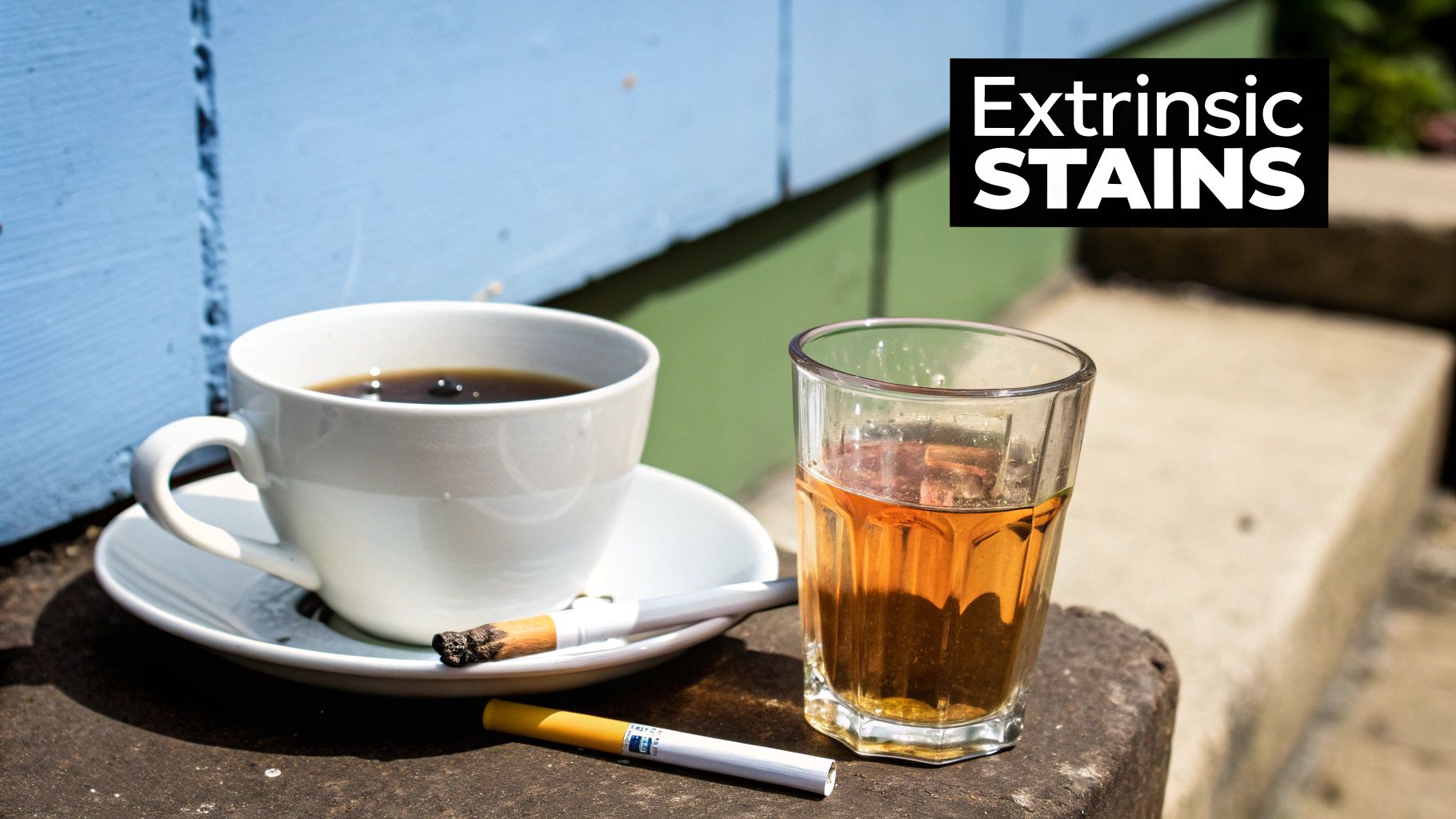
If you’ve noticed your smile isn’t as bright as it once was, you’re not alone. The most common culprit is what we call extrinsic discolouration – a fancy term for the stains that accumulate on the surface of your teeth from the things we enjoy every day. It helps to think of your tooth enamel like a pristine white kitchen tile; over time, spills and splatters will inevitably leave their mark.
This staining happens because of microscopic culprits called chromogens. These are compounds with strong pigments that are abundant in many of our favourite foods and drinks. They have a real talent for latching onto your tooth enamel. That morning coffee, that evening glass of red wine, and even healthy dark berries are all loaded with these chromogen molecules.
But chromogens rarely act by themselves. Many of the same foods and drinks also contain tannins, which are plant-based compounds that give stains a helping hand.
Think of tannins as a primer for paint. They essentially make the surface of your enamel a bit stickier, which allows the colourful chromogens to grab on much more effectively and cause that dull, discoloured look. This is exactly why drinks like black tea are such notorious stainers.
This powerful duo of chromogens and tannins is one of the main reasons so many of us experience tooth discolouration. It doesn’t happen overnight, of course. It’s a slow, creeping process, but after months and years, the build-up can really take the shine off your smile.
Lifestyle Choices and Stubborn Stains
Beyond what we eat and drink, certain habits can dramatically accelerate staining. Unsurprisingly, smoking or using tobacco products is one of the biggest offenders. The tar and nicotine in tobacco create a stubborn, yellowish-brown film that works its way into the tiny, porous surface of your tooth enamel.
These kinds of stains are incredibly tough to get rid of with just a toothbrush. The residue is sticky and tenacious, meaning even the most dedicated daily brushing routine often isn’t enough to combat it. The discolouring effects of tobacco can quickly undo all your hard work.
How to Manage Everyday Discolouration
So, what’s the solution? Giving up coffee or curry for good isn’t a practical option for most of us. The better approach is to build small, consistent habits to lessen their impact.
- Rinse After Indulging: After a coffee, a curry, or a glass of wine, simply swishing your mouth out with plain water can wash away many of the staining compounds before they get a chance to settle in.
- Use a Straw: When you’re drinking dark liquids like cola or iced tea, using a straw is a simple trick to help the drink bypass your front teeth, which are most visible when you smile.
- Don’t Brush Immediately: This might sound counterintuitive, but brushing right after having something acidic (like wine or citrus fruits) can actually scrub the acid into your enamel and cause damage. It’s best to wait at least 30 minutes before brushing.
While these tips are great for day-to-day management, they might not be enough to shift deep-set discolouration. A professional cleaning at the dentist can remove some surface build-up, but for a noticeably whiter smile, you’ll likely need a cosmetic treatment. Modern, affordable solutions prescribed by a real dentist—like the treatments available through Toothfairy—can safely and effectively lift years of stains, giving you back your smile’s natural glow without the hefty price tag or hassle of a traditional clinic.
When Discolouration Comes from Inside the Tooth
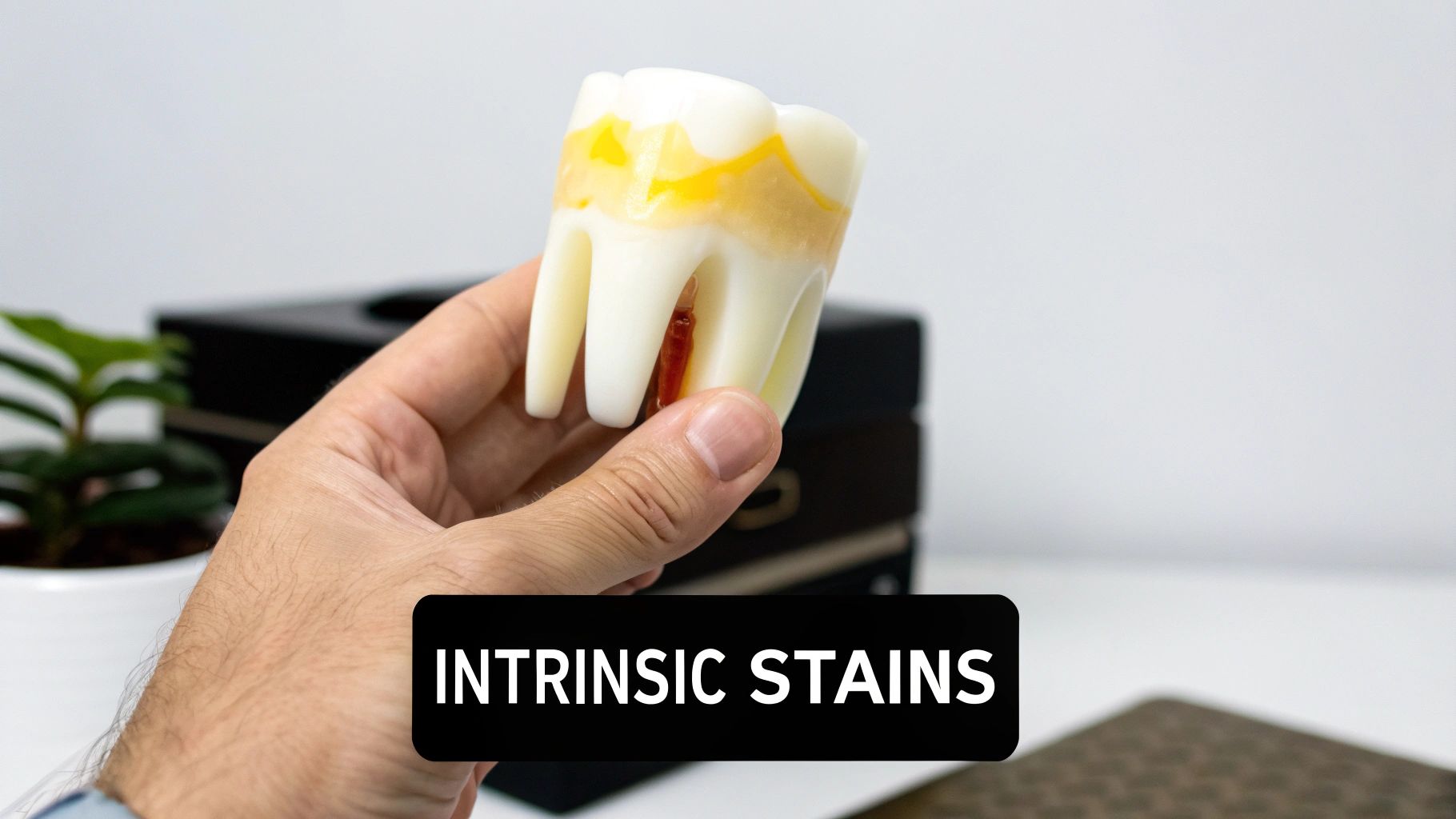
While we often focus on the everyday culprits that stain the surface of our teeth, some discolouration is more than just skin deep. This is what we call intrinsic discolouration—a change in colour that originates from within the tooth itself. It’s the reason why some stubborn stains simply won’t lift, no matter how diligently you use whitening toothpaste. The problem isn’t on the surface, it’s coming from the inside.
One of the most common causes is something none of us can avoid: getting older. Over the years, the tough, white outer layer of your teeth, the enamel, naturally starts to wear thin. As it thins, the layer beneath it, known as dentin, becomes more visible. Dentin has a naturally yellowish hue, which explains why our teeth can look more yellow as we age, even if we’ve maintained excellent oral hygiene.
It’s a subtle shift that happens over decades, but it’s a fundamental change to the tooth’s actual structure. This is precisely why over-the-counter whitening strips often seem to have little to no effect on age-related yellowing.
Trauma and Dental Decay
A much more abrupt cause of intrinsic staining is dental trauma. A sudden, hard knock to a tooth—perhaps from a sports injury or an accidental fall—can damage the blood supply to the nerve inside. When the tooth’s nerve “dies,” the blood cells break down, releasing dark pigments that stain the dentin from the inside out. This often leads to a single tooth turning a very noticeable grey, brown, or sometimes even black.
Dental decay can work in a similar way. A cavity isn’t just a hole; it’s a bacterial infection that destroys tooth tissue. As the decay eats its way deeper into the dentin, the affected tissue darkens, creating dark spots that are visible right through the enamel.
In the UK, the link between tooth decay and discolouration is a serious concern, especially for young children. A 2022 survey in England revealed some stark figures: 29.3% of five-year-olds showed signs of visible dental decay. Even more telling is that 23.7% had decay that had already penetrated the dentin, with these children having an average of 3.5 affected teeth. When decay reaches the dentin, it causes deep-seated intrinsic stains as the infected tissue darkens. You can delve deeper into the data on the connection between childhood decay and dental health.
Medications and Developmental Factors
Sometimes, the root cause of discolouration goes all the way back to childhood. Certain antibiotics, especially tetracycline, can cause deep and permanent staining if they are taken while the teeth are still developing. This often results in very distinctive horizontal bands of grey or brown embedded within the tooth’s structure.
Another developmental issue is fluorosis. While fluoride is brilliant for preventing cavities, getting too much of it during early childhood can interfere with how the enamel forms. This can lead to anything from faint, lacy white lines to more severe and noticeable brown mottling on the teeth.
Because these intrinsic issues change the very core of the tooth, they need a completely different strategy. Surface-level treatments just won’t cut it. To restore a bright, confident smile, you’ll often need professional cosmetic solutions like internal bleaching, bonding, or veneers. Finding the right path is made much easier with a modern platform like Toothfairy, which connects you directly with dentists who can diagnose the true cause and design the most effective and affordable cosmetic plan for your unique needs.
How Your Health and Habits Affect Your Smile
Ever wonder why your smile isn’t as bright as it used to be? It’s rarely down to just one thing. Your smile’s brightness is often a direct reflection of your daily routines and your overall health. Think of it as a story told by your age, your lifestyle, and how you care for your body all rolled into one.
The most obvious place to start is your oral hygiene routine. If brushing and flossing aren’t regular habits, a sticky, invisible film of bacteria called plaque starts to build up. This plaque creates a slightly rough surface on your teeth, giving stains from coffee, tea, and food the perfect place to cling and dull your smile.
“Your tooth colour is a holistic indicator. It reflects not just your diet, but your age, your health history, and even your access to care. Recognising this connection is the first step toward proactive dental health.”
This connection between lifestyle and tooth colour isn’t just anecdotal; it’s something we see across different communities. How people feel about their tooth colour often lines up with known causes like dental decay and certain habits. A UK-based study highlighted this, finding that while about 50% of people thought their tooth colour was normal, those from more deprived areas—where access to dental care can be a challenge—were more likely to be unhappy with their smile. You can read more about these socio-demographic links to tooth colour perception.
The Combined Impact of Ageing and Health
As the years go by, it’s not just one factor but a whole combination of things that can change the colour of our teeth. For one, our protective enamel naturally gets thinner over time, which lets the yellower layer underneath, called dentin, show through more.
Then you have to add in a lifetime of habits. All those morning coffees, celebratory glasses of red wine, and colourful curries leave behind tiny stains that build up year after year, becoming more noticeable as we get older.
Certain health issues and their treatments can also play a part, causing what’s known as intrinsic discolouration—stains that come from inside the tooth. Medical treatments like chemotherapy and radiation, especially around the head and neck, can sometimes affect how teeth develop and change their colour.
Here’s a quick look at how these factors can team up:
- Ageing: Enamel thins out, revealing the naturally yellow dentin.
- Lifestyle: Years of staining foods and drinks leave their mark on the enamel.
- Health Conditions: Certain illnesses or medications can alter the tooth’s internal colour.
Ultimately, getting to the bottom of tooth discolouration means looking at the whole picture. It’s a great reminder that consistent, thoughtful dental care is about so much more than just surface treatments. This is where modern solutions like Toothfairy come in, offering a smarter, more affordable way to manage your oral health—from handling dental emergencies to providing cosmetic treatments that address the real reason for your discolouration.
Modern Ways to Restore Your Smile’s Brilliance
Knowing what’s dulling your smile is one thing, but figuring out how to get its sparkle back is the real game-changer. Thankfully, dentistry has come a long way, offering a whole toolkit of options to tackle everything from everyday surface stains to deeper, more stubborn discolouration. There’s a clear path back to a smile you’ll love to show off.
Your first port of call, and often the simplest fix, is a professional dental cleaning. This is so much more than just a really good brush. A dentist or hygienist uses specialised instruments to scrape away hardened plaque (tartar) and polish off many of the surface stains that coffee, tea, and life in general leave behind. For a lot of people, a thorough clean is all it takes to see a real difference.
Professional Whitening for Deeper Stains
But what about when stains have worked their way deeper into the enamel? That’s where professional teeth whitening comes in. Unlike the whitening kits you find on shop shelves, which often contain low concentrations of the active ingredient, dentist-led treatments use powerful, yet safe, formulas to break down those tenacious chromogens. The professional-grade gel gets inside the enamel to bleach the discoloured molecules, leaving you with a genuinely whiter smile.
It’s absolutely vital that a dentist oversees this process. They’re the only ones who can properly check if your teeth and gums are healthy enough for the treatment. They can also customise the strength and application to fit your exact needs, which means better results with less sensitivity. It’s a much safer and more effective path than trying to figure it all out on your own. For those who enjoy exploring different avenues in their oral care, products like an Ayurvedic Charcoal White Toothpaste are also becoming a popular addition to a well-rounded routine.
Advanced Solutions for Intrinsic Discolouration
For those deep-set intrinsic stains—the kind that come from within the tooth due to things like trauma, certain medications, or simply ageing—surface whitening just won’t cut it. This is where modern cosmetic dentistry really steps up, with clever solutions designed to completely cover the discolouration.
- Composite Bonding: Think of this as artistry for your teeth. A dentist skilfully applies and sculpts a tooth-coloured resin directly onto the tooth’s surface, masking stains and other imperfections. It’s a fantastic, quick fix for one or two problem teeth.
- Porcelain Veneers: These are super-thin, custom-crafted shells of ceramic that are bonded to the front of your teeth. Veneers are the ultimate smile makeover, creating a brand-new, perfectly white surface that’s also highly resistant to future stains.
The right treatment depends entirely on what’s causing the discolouration. Getting a professional diagnosis isn’t just a good idea—it’s essential for achieving results that are beautiful, safe, and built to last.
Finally, never underestimate the power of straight teeth. A well-aligned smile isn’t just about looks; it directly impacts colour. When your teeth are straight, they’re far easier to clean properly, which stops plaque and stains from building up in those tricky, crooked spots. On top of that, straight teeth reflect light more evenly, which creates the natural illusion of a brighter, healthier smile.
This is exactly where a service like Toothfairy becomes so valuable. Instead of trying to navigate all these options by yourself or putting up with the long waits and high costs of traditional clinics, our platform offers a smarter, more affordable way forward. We connect you with qualified UK dentists who can diagnose the cause of your discolouration, prescribe professional-grade whitening, or even manage your entire clear aligner journey. We’re here to help you achieve a smile that’s not just straighter and brighter, but easier to keep clean for years to come.
Common Questions About Tooth Discolouration
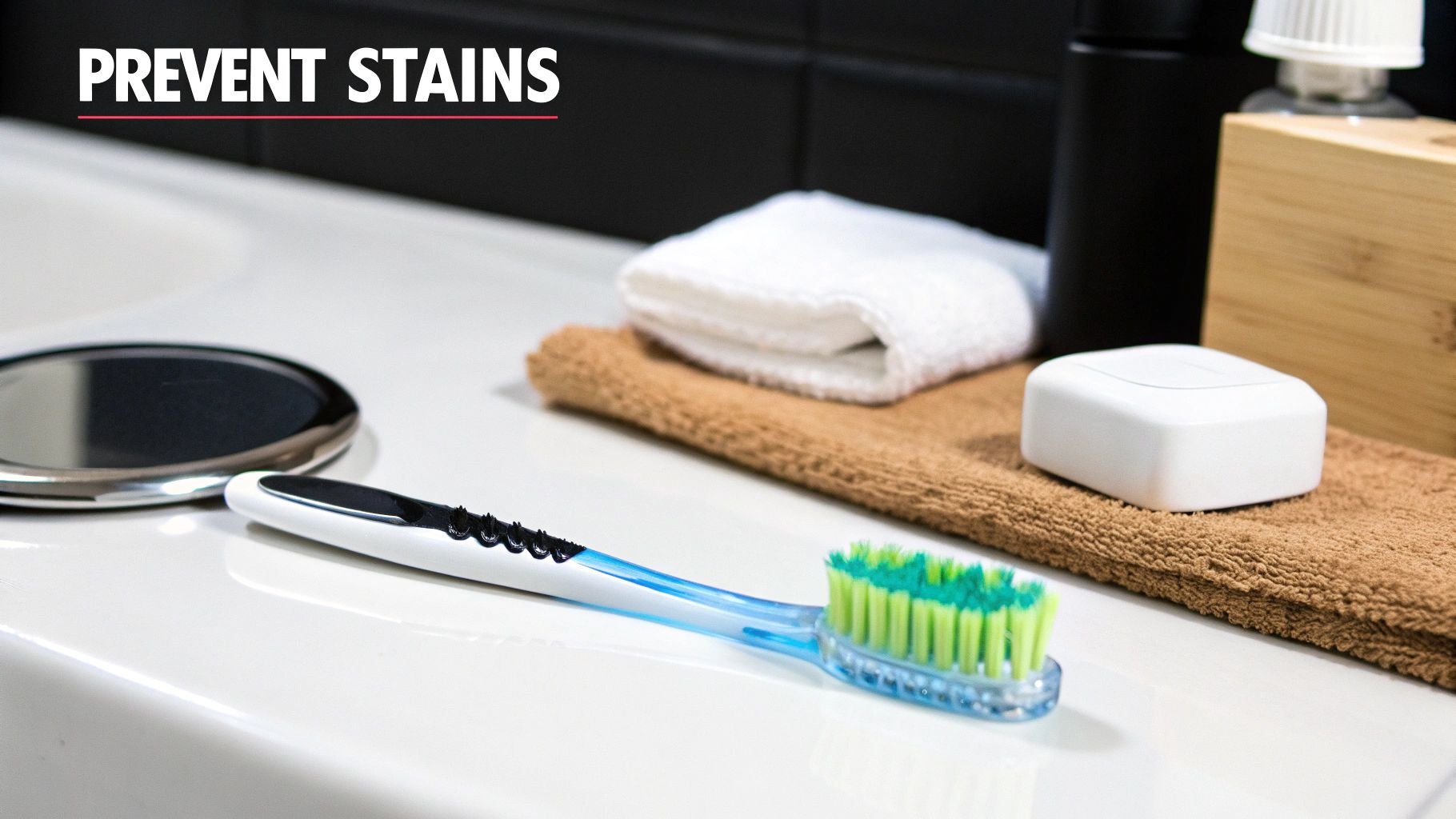
Even after learning what causes teeth to lose their sparkle, it’s completely normal to have more questions. Deciding what to do about your smile is a big deal, and getting straightforward, practical answers is the final piece of the puzzle. Let’s tackle some of the most common queries we hear from patients to help you see the path forward.
It’s easy to feel a bit overwhelmed by all the information out there. By breaking it down into specific concerns—from prevention to safety—you can get a much clearer picture of what will work for you.
Can I Reverse Tooth Discolouration Naturally?
This is a question we get all the time, especially with the rise of DIY health trends. The short answer is that for very light, fresh surface stains, a fantastic brushing and flossing routine can certainly help keep them in check. However, you need to be extremely cautious with so-called “natural” whitening hacks.
Things like activated charcoal, baking soda, and acidic fruits (lemons, I’m looking at you) are often touted as miracle whiteners. The truth? They are incredibly abrasive. Using them is like taking sandpaper to your teeth; you might scrub off some stains, but you’ll also scrub away your precious enamel for good.
Once enamel is gone, it’s gone forever. This not only leads to painful sensitivity but can ironically make your teeth look even more yellow because the darker dentin layer underneath starts to show through.
For safe, predictable, and genuinely effective results, professional dental treatments are the only proven way forward. They are designed to lift stains without harming your tooth structure, avoiding the irreversible damage that abrasive home remedies can cause.
What Is the Best Way to Prevent Tooth Discolouration?
The best defence is always a good offence. Preventing discolouration comes down to a two-pronged approach: smart daily habits combined with consistent professional care.
Your daily routine is your first line of defence:
- Brush twice a day with a good fluoride toothpaste to remove plaque and fresh stains before they set.
- Floss at least once daily to clear out the tight spaces between teeth where stains love to hide.
- Rinse with water right after having coffee, tea, red wine, or other strongly coloured foods and drinks.
- Avoid smoking and all tobacco products. This is one of the single biggest things you can do to prevent stubborn, deep-set yellow and brown stains.
These habits are your foundation, but they can’t do it all. The second crucial part is keeping up with your regular dental check-ups and hygiene appointments. A professional clean is the only way to remove hardened plaque (tartar) and polish away the surface stains your toothbrush simply can’t handle.
Is Professional Teeth Whitening Safe for My Teeth?
Absolutely, yes—with one very important condition: it must be supervised by a qualified dental professional. When a dentist is in charge, teeth whitening is an incredibly safe and effective cosmetic procedure.
The key word here is supervised. Before any treatment, a dentist will perform a thorough check-up to make sure your teeth and gums are healthy enough. Whitening isn’t a one-size-fits-all fix; it’s not suitable for people with active gum disease, untreated cavities, or badly worn enamel.
It’s also crucial to remember that whitening gels do not work on dental work like crowns, veneers, or fillings. They will lighten the natural teeth around them, but the restorations will stay their original colour, resulting in a mismatched smile. This is exactly why a professional consultation is non-negotiable. Platforms like Toothfairy connect you with a real dentist who assesses your unique situation and prescribes the right treatment, helping you sidestep the risks of unsupervised, over-the-counter kits.
Why Are My Teeth Still Yellow If I Brush Every Day?
This is an incredibly common—and frustrating—experience for so many people. If you’re diligent with your brushing but still aren’t happy with the colour of your teeth, a few things are likely at play.
First, your discolouration might be intrinsic, meaning the stain is coming from inside the tooth. As we age, our enamel naturally thins, allowing the yellower dentin layer underneath to become more visible. No amount of brushing can change the colour of your dentin.
Second, you could be dealing with extrinsic stains that have settled deep into your enamel over many years. Regular toothpaste just isn’t powerful enough to lift these deep-set stains; it takes a professional-strength whitening agent to penetrate the enamel and break them down.
Finally, there’s genetics. Just as we inherit our hair and eye colour, our natural tooth shade is also hereditary. Some of us simply have teeth with a naturally warmer, yellower hue. A dental professional can get to the bottom of it and guide you towards a solution that will actually deliver results—whether that’s professional whitening, composite bonding, or veneers for the most persistent cases.
Ready to take the next step towards a brighter, more confident smile? Instead of guessing what might work, get a professional diagnosis and a personalised treatment plan from the comfort of your home. Toothfairy offers a smarter, more affordable way to access cosmetic dentistry, from professional whitening to clear aligners, all prescribed and supervised by qualified UK dentists. Find out how Toothfairy can transform your smile today.
Last updated on August 15, 2025

Toothfairy Care Team
Toothfairy, is the world's smartest dental app, that connects patients to a dentist for a range of issues, from emergencies, cosmetics, prescriptions to virtual exams.
Toothfairy Care Team
Toothfairy, is the world's smartest dental app, that connects patients to a dentist for a range of issues, from emergencies, cosmetics, prescriptions to virtual exams.
